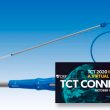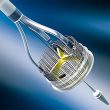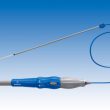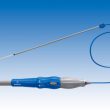Implant depth greater than the length of the membranous septum is an independent predictor of permanent pacemaker implantation. Valve implantation 3 to 5 mm below the aortic annulus in a projection coaxial to the device is recommended. The problem is this is rarely in the annular plane of the valve. Ideal annular plane projection is<a href="https://solaci.org/en/2021/03/25/cusp-overlap-for-higher-corevalve-implantation/" title="Read more" >...</a>
TCT 2020 | Acurate Neo Does Not Meet Non-Inferiority vs. CoreValve Evolut
The self-expanding Acurate Neo (Boston Scientific) did not meet non-inferiority vs. the self-expanding CoreValve Evolut (Medtronic) in the SCOPE 2 study published in Circulation simultaneously and presented at the virtual TCT 2020. These are bad news for the Acurate Neo, that had already failed to show non-inferiority vs. the Sapien 3 in the SCOPE 1<a href="https://solaci.org/en/2020/10/21/tct-2020-acurate-neo-does-not-meet-non-inferiority-vs-corevalve-evolut/" title="Read more" >...</a>
Lotus Returns with New Strength and the FDA Approval to Compete with Sapien3 and CoreValve Evolut R
After reports of some serious adverse events with first-generation Lotus, the device was pulled off the market—but it was not meant to be left in oblivion. Now, it is back, renewed and with the approval of the United States Food and Drug Administration (FDA), to compete directly with the two market leaders (Sapien and CoreValve),<a href="https://solaci.org/en/2019/04/29/lotus-returns-with-new-strength-and-the-fda-approval-to-compete-with-sapien3-and-corevalve-evolut-r/" title="Read more" >...</a>
CoreValve US Pivotal High Risk Trial: at 5 years, similar results
Courtesy of Dr. Carlos Fava. We are well aware of transcatheter aortic valve replacement’s (TAVR) effect in high-risk or inoperable patients at 5 years, even more after the PARTNER 1 trial. Yet, the outcomes of another relevant randomized study remained pending: el CoreValve US Pivotal High-Risk Trial. The CoreValve US Pivotal High-Risk Trial looked at the<a href="https://solaci.org/en/2018/11/21/corevalve-us-pivotal-high-risk-trial-at-5-years-similar-results/" title="Read more" >...</a>
Positive Outcomes of CoreValve Evolut in Large Population
The Evolut R, as well as its predecessor the CoreValve, is a self-expandable valve, supra-annular, made of porcine pericardium in a nitinol frame. Amongst its improvements, it has a better profile and the option to resheath. This makes it fully repositionable and even recapturable. We only needed to confirm these technical advantages would translate into clinical<a href="https://solaci.org/en/2017/08/30/positive-outcomes-of-corevalve-evolut-in-large-population/" title="Read more" >...</a>
REPRISE III: Lotus and CoreValve Compared in High-Risk or Inoperable Patients
The efficacy of transcatheter aortic valve replacement (TAVR) has been well-established. However, its limitations include suboptimal deployment and paravalvular leak. The Lotus system is a fully repositionable and retrievable device with controlled mechanical expansion. It features an adaptive seal to minimize paravalvular leak, it does not require early pacing during deployment, and, given its early<a href="https://solaci.org/en/2017/05/23/reprise-iii-lotus-and-corevalve-compared-in-high-risk-or-inoperable-patients/" title="Read more" >...</a>
Evolut R: Clinical Results Might Be Better than Those for First-Generation CoreValve
Two recent articles featured in JACC Cardiovascular Interventions showed that short term (at 30 days) outcomes of patients treated with the next-generation self-expanding Medtronic Evolut R valves could present several advantages compared to the original CoreValve, including recapturability. Both analyses reported similar rates of all-cause mortality and stroke. The study carried out by Dr. Jeffrey Popma as<a href="https://solaci.org/en/2017/02/23/evolut-r-clinical-results-might-be-better-than-those-for-first-generation-corevalve/" title="Read more" >...</a>
Stroke Predictors in TAVR: CoreValve vs. Sapien
A comprehensive analyzis of cerebrovascular events in major randomized controlled studies on transcatheter aortic valve replacement (TAVR) has shown some interesting data on both risks and timing of stroke in this setting. The study carried out by Dr. Neal Kleiman, reviewed data on stroke and stroke predictors among 3,687 patients included in the CoreValve<a href="https://solaci.org/en/2016/09/21/stroke-predictors-in-tavr-corevalve-vs-sapien/" title="Read more" >...</a>
Medtronic’s New CoreValve Evolut R for TAVR
Original Title: Treatment of Symptomatic Severe Aortic Stenosis with a Novel Resheathable Supra-Annular Self-Expanding Transcatheter Aortic Valve System. Reference: Ganesh Manoharan et al. J Am Coll Cardiol Intv. 2015; 8(10):1359-1367. Courtesy of Dr. Agustín Vecchia. Despite the rapid growth and evolution of transcatheter aortic valve replacement devices (TAVR), vascular access complications, paravalvular leak, stroke<a href="https://solaci.org/en/2016/07/08/medtronics-new-corevalve-evolut-r-for-tavr/" title="Read more" >...</a>
CoreValve US Pivotal: at 3 Years, the Self-Expanding Valve Maintains Its Advantage vs. Surgery
At 3 year follow up, the CoreValve US Pivotal study on high risk elderly patients, the self-expanding valve showed a lasting benefit vs. surgery. These findings could suggest that the self-expanding valve should be considered the preferred treatment in patients with symptomatic severe aortic stenosis at increased risk for surgery. The study included 797 patients<a href="https://solaci.org/en/2016/04/08/corevalve-us-pivotal-at-3-years-the-self-expanding-valve-maintains-its-advantage-vs-surgery/" title="Read more" >...</a>









